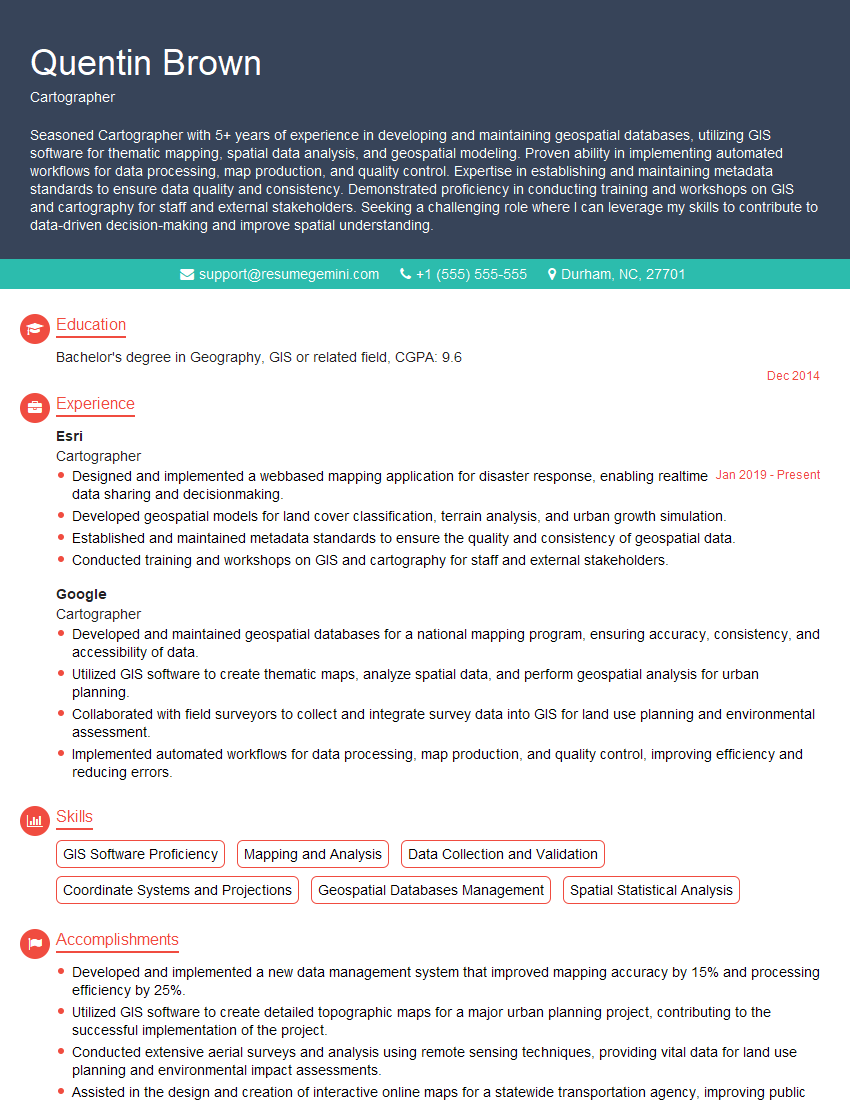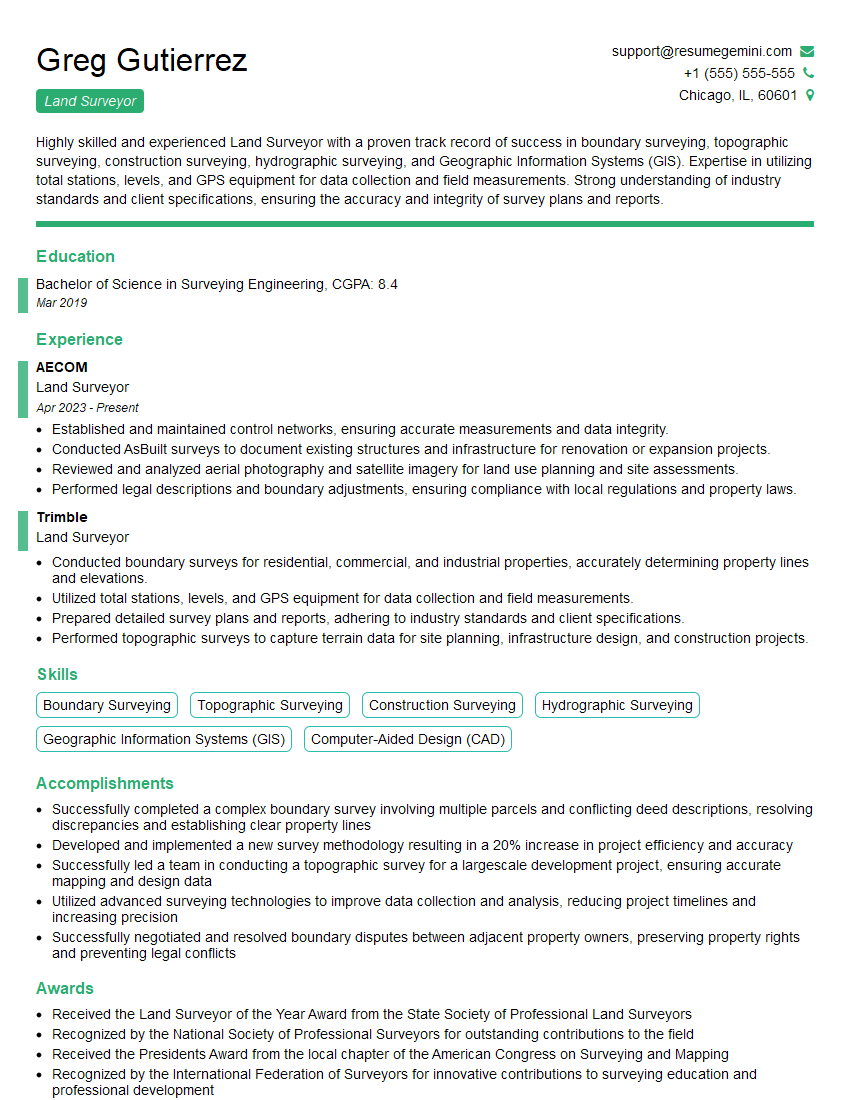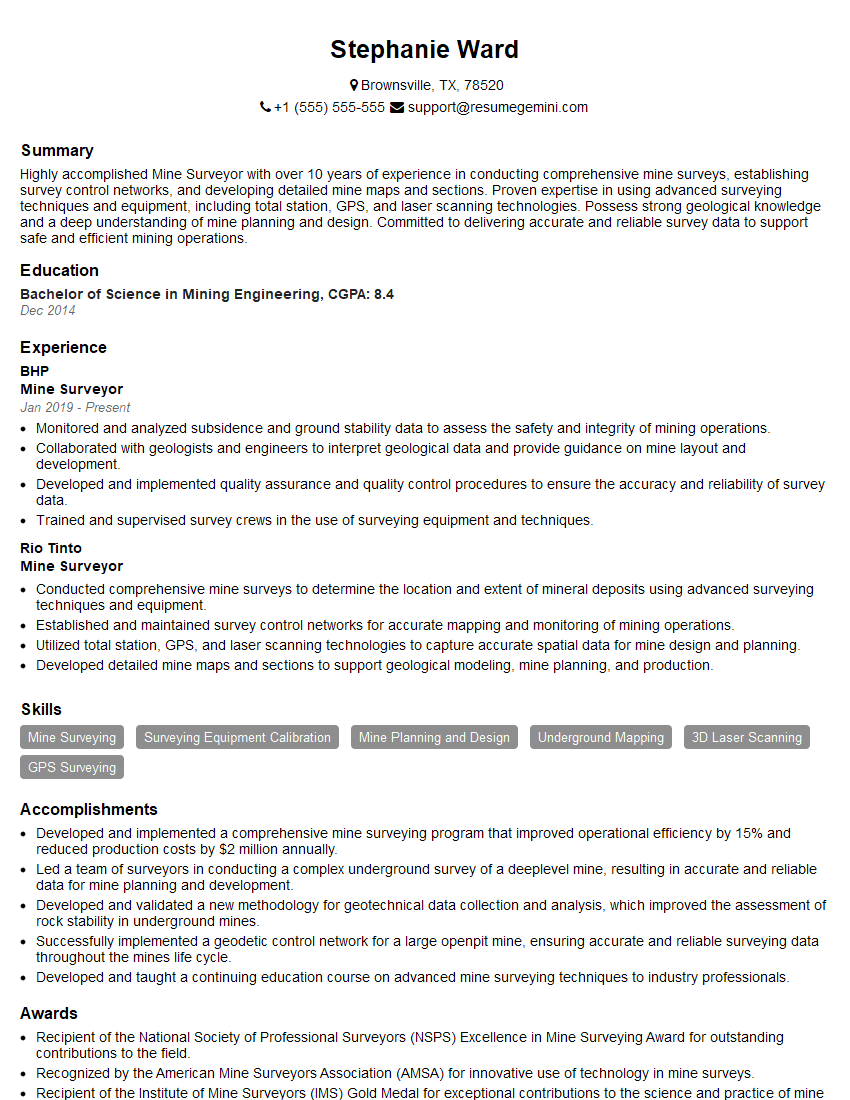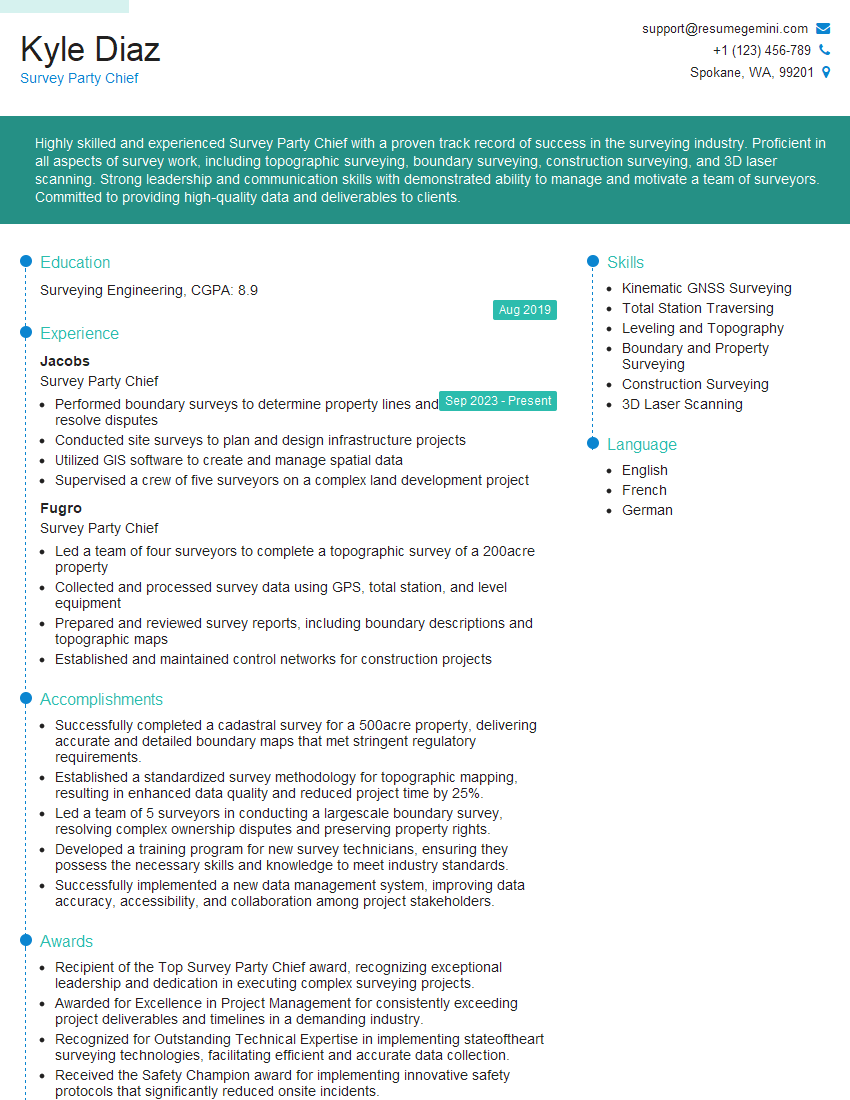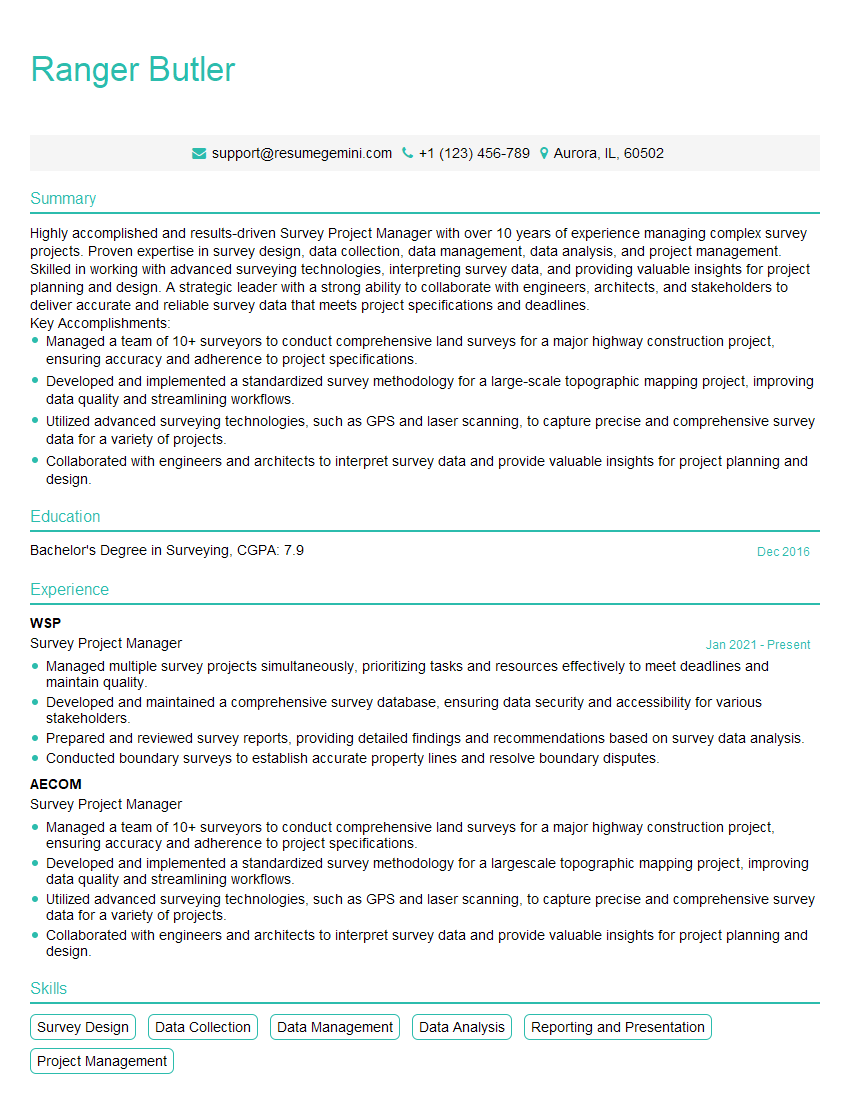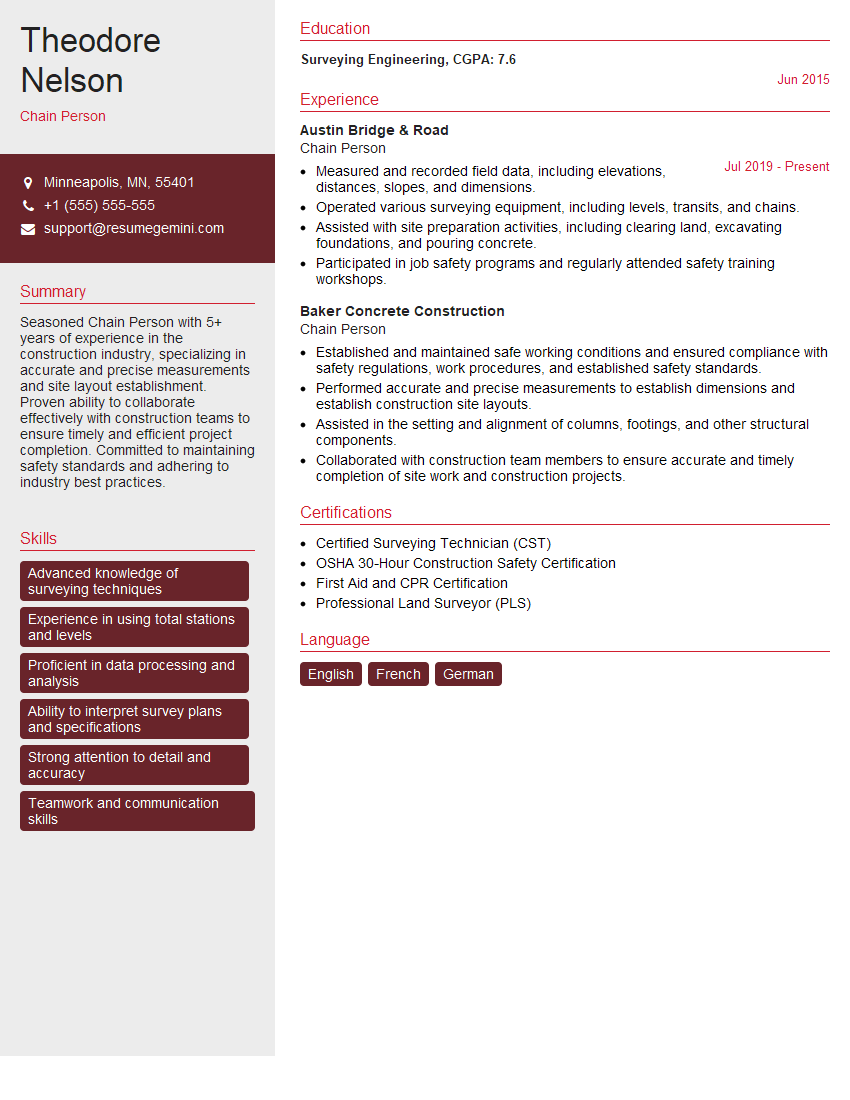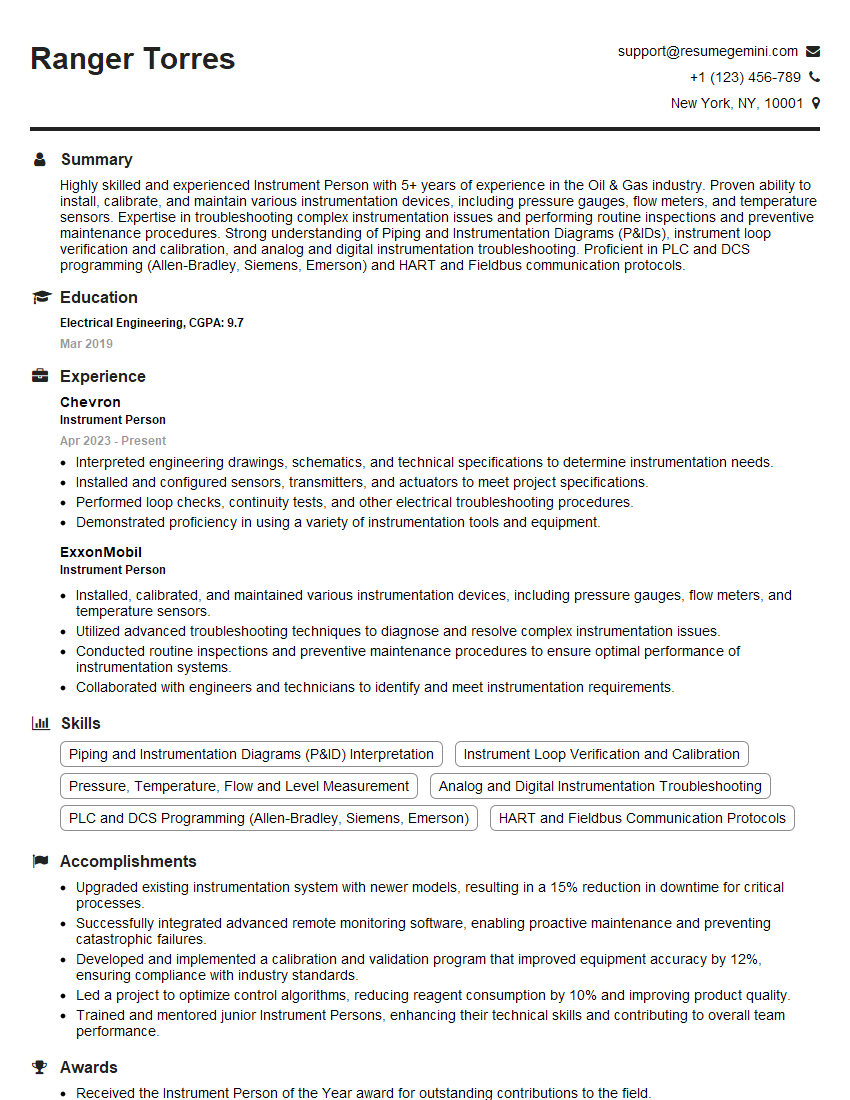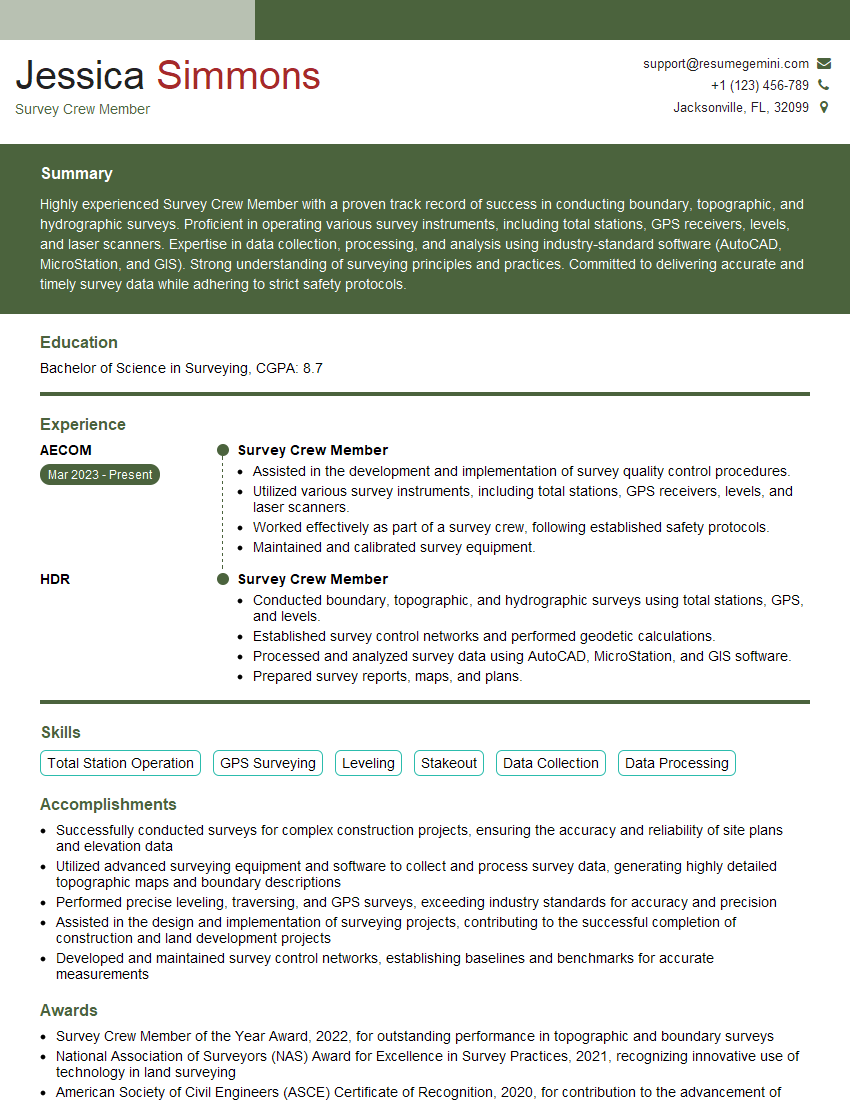The right preparation can turn an interview into an opportunity to showcase your expertise. This guide to Basic Land Surveying interview questions is your ultimate resource, providing key insights and tips to help you ace your responses and stand out as a top candidate.
Questions Asked in Basic Land Surveying Interview
Q 1. Explain the difference between a traverse and a triangulation survey.
Both traversing and triangulation are fundamental surveying techniques used to determine the relative positions of points, but they differ significantly in their approach. Think of traversing as walking a path, meticulously measuring each step and its direction, while triangulation is like using a network of interconnected triangles to pinpoint locations from afar.
Traversing: Involves measuring a series of connected lines (legs) along a path, along with their directions (angles). The lengths and angles are measured using equipment like total stations or EDM (Electronic Distance Measurement) devices and theodolite. This process creates a polygon, and coordinates of points are calculated by successively adding measurements. Traversing is suitable for detailed surveys over relatively short to medium distances.
Triangulation: Relies on measuring angles between points to determine their relative positions. It’s based on the geometric principles of triangles, and it is most useful for establishing the control points of a large area. The base line (one side of the first triangle) is precisely measured, and angles are meticulously observed at each point. The lengths of the other sides of the triangles are computed using trigonometry. Triangulation is effective for long-distance control surveys, especially in challenging terrains.
In essence: Traversing measures distances and angles directly; triangulation calculates distances indirectly from measured angles and a known base line. Traversing is more labor-intensive for large areas but gives more detailed information along the traverse line. Triangulation is quicker for covering large areas with fewer points.
Q 2. What are the common sources of error in surveying measurements?
Surveying measurements are susceptible to various errors, broadly categorized as systematic and random errors. Think of it like baking a cake; systematic errors are like consistently using a faulty measuring cup, always resulting in the same mistake. Random errors are like the unpredictable variations in oven temperature.
- Systematic Errors: These errors follow a pattern and are often caused by instrument malfunction (e.g., poorly calibrated equipment), procedural flaws (e.g., incorrect leveling), or environmental factors (e.g., temperature affecting tape length). They can be minimized through careful calibration, proper techniques, and environmental corrections.
- Random Errors: These errors are unpredictable and arise from various sources, including human observation errors, instrument limitations (e.g., reading a scale imperfectly), and random environmental influences (e.g., slight wind affecting a plumb bob). They can be reduced through repeated measurements and statistical analysis (like averaging multiple readings).
- Gross Errors: These are large mistakes caused by human error, often due to carelessness or misinterpretation, such as misreading a measurement or recording it incorrectly. These errors require careful review of field notes and data.
Examples: Using a tape measure that’s stretched or a theodolite that’s not properly leveled lead to systematic errors, while human error in reading an angle or recording a measurement contributes to random errors.
Q 3. Describe the process of establishing a benchmark.
Establishing a benchmark is crucial for providing a stable, precisely known elevation reference point for future surveys. Imagine it as a permanent marker indicating the ‘zero’ height of a region. The process is quite involved and requires precision:
- Site Selection: Choose a stable, accessible location, ideally a permanent feature like a solid rock outcrop or a robust concrete structure. Avoid locations prone to erosion or disturbance.
- Setting the Mark: A durable marker is set at the chosen location, usually a bronze or stainless steel disk embedded in concrete or rock. The exact elevation of the mark is carefully determined.
- Precise Levelling: The elevation is determined using precise levelling techniques, often involving multiple leveling setups to reduce the effects of instrument and observational errors. This often involves a highly accurate level and levelling staff.
- Documentation: All details, including the benchmark’s coordinates, elevation, description of its location, and date of establishment, are meticulously recorded in survey notes and possibly stored in a database. Photos of the benchmark and its surroundings are beneficial too.
The benchmark then serves as a reference for future surveys. When subsequent surveys are carried out, elevations of other points can be determined relative to this established benchmark, ensuring consistency and accuracy.
Q 4. How do you compensate for curvature and refraction in long distance measurements?
Curvature and refraction affect long-distance measurements, causing the observed line of sight to deviate from the true horizontal. Curvature is due to the Earth’s curvature; refraction is due to the bending of light rays in the atmosphere. Compensation for these effects is crucial for accuracy.
Compensation Methods:
- Curvature Correction: This correction accounts for the downward curvature of the Earth. The formula to calculate the curvature correction (C) is often given as:
C = 0.06737 * d^2 * (d in kilometers)orC = 0.020673 * d^2 (d in meters)where ‘d’ is the distance. - Refraction Correction: This correction accounts for the bending of light rays due to changes in atmospheric density. It’s typically expressed as a factor (k) times the curvature correction, usually considered to be approximately 0.133 to 0.166 times the curvature correction. So, Refraction Correction (R) is calculated as
R = k*C - Combined Correction: The combined effect of curvature and refraction is calculated as (C-R), effectively reducing the effect of curvature using the refraction correction. It’s often simplified to approximately 0.06737* (0.833) * d^2
By applying these corrections, surveyors accurately determine the true horizontal distance, ensuring accurate results for long-distance measurements. It’s critical to select suitable calculation method or instrument settings if using instruments which incorporate such corrections automatically.
Q 5. What are the different types of levels used in surveying?
Several types of levels are employed in surveying, each suited to different tasks and precision requirements. They all share the basic principle of establishing a horizontal line of sight.
- Dumpy Level: A robust and simple level, ideal for general leveling tasks. It uses a telescope mounted on a leveling head for accurate sighting. Dumpy levels are known for their durability but can be somewhat less precise than other types.
- Tilting Level: Offers improved precision because it incorporates a tilting screw that allows for precise leveling of the telescope without significant adjustments to the level’s overall position. Faster than the dumpy level and provides high precision.
- Automatic Level (Self-Leveling Level): These levels automatically level the telescope using a compensator mechanism, greatly accelerating the leveling process. They are user-friendly and very efficient, though they may need regular calibration.
- Digital Level: Combines the features of an automatic level with digital readouts, allowing for direct data capture and improved speed and efficiency. It reduces human errors often associated with manual recording of data from traditional levels.
The choice of level depends on the project’s accuracy requirements and the surveyor’s preferences. For highly precise work, a tilting or digital level might be preferred, while for less demanding tasks, a dumpy level might suffice.
Q 6. Explain the principle of least squares adjustment.
The principle of least squares adjustment is a powerful statistical method used to resolve discrepancies between observed measurements and their theoretical values in surveying. Imagine you have multiple measurements of the same distance, each with some inherent error. Least squares finds the ‘best fit’ solution that minimizes the sum of the squares of the differences between the observed values and the adjusted values.
How it Works: The method uses mathematical techniques to adjust the measured values so that they best fit a mathematical model, e.g., the geometry of a traverse or a triangulation network. The ‘best fit’ is the one that minimizes the sum of the squared differences (residuals) between the observed and adjusted values. This method ensures that all measurements contribute to the final adjusted values in a statistically consistent way, minimizing the overall impact of errors.
Practical Application: In surveying, least squares adjustment is crucial for resolving discrepancies in measurements caused by errors. It’s used to adjust the angles and distances of a traverse to ensure the polygon closes correctly, and in network adjustment to reconcile discrepancies between observations from different stations. This leads to more accurate and reliable survey results.
The least squares method is not merely a tool to solve inconsistencies. Its fundamental value lies in its use of statistical analysis to provide an estimation of uncertainty, confidence intervals and standard deviation for the computed values. These statistical values are vital in expressing the precision of the survey results.
Q 7. Describe the various methods of determining elevation.
Determining elevation is fundamental to surveying. Several methods are employed, each with its own strengths and limitations:
- Leveling: This is the most precise method for determining relative elevations. It involves using a level to establish a horizontal line of sight and measuring the vertical distance (difference in elevation) between points using a leveling staff. There are various leveling techniques, such as differential leveling (for short distances) and reciprocal leveling (to eliminate systematic error).
- Trigonometric Leveling: This method uses measurements of angles and distances to calculate elevations indirectly. It’s useful when direct leveling is impractical, such as across a valley or wide river. It involves using a theodolite and measuring vertical angles from a point of known elevation.
- GPS (Global Positioning System): GPS receivers provide three-dimensional coordinates, including elevation, by measuring distances to multiple satellites. This method is increasingly popular but can be affected by atmospheric conditions and multipath error. Precise GPS techniques are generally required for surveying-grade accuracy.
- Barometric Leveling: This method uses a barometer to measure atmospheric pressure, which is related to altitude. It’s suitable for less precise measurements over larger areas, often used in topographic mapping. This is not usually considered highly accurate for surveying purposes.
The selection of the method depends on project requirements, accuracy needed, and the available technology. For precise elevation determination over short distances, leveling is preferred. For large areas, GPS or trigonometric levelling might be more suitable. Barometric leveling is usually restricted to approximate elevation measurements.
Q 8. What is the purpose of a control survey?
A control survey establishes a network of precisely located points, forming a framework for all subsequent surveys in a project. Think of it as building a strong foundation for a house – without it, everything else becomes unstable and inaccurate. These points act as horizontal and vertical control, providing reliable reference points for measurements. This is crucial because it ensures consistency and accuracy across the entire project. For example, in a large construction site, a control survey might involve establishing benchmarks with known elevations and coordinates, which are then used to control the positioning of buildings, roads, and utilities.
The purpose is to provide a high-degree of accuracy and reliability to all other surveys tied to it. Without a control survey, minor errors can accumulate, leading to significant discrepancies in the final product. Imagine trying to build a large building without precise measurements – it would quickly become a disaster.
Q 9. What are the different types of surveying equipment you are familiar with?
I’m proficient in using a variety of surveying equipment. This includes:
- Total Stations: These are highly accurate electronic instruments that measure angles and distances. They are essential for setting out points and collecting data for topographic surveys.
- Global Navigation Satellite Systems (GNSS) Receivers (e.g., GPS): GNSS receivers use signals from satellites to determine precise three-dimensional coordinates. I have experience using both single-frequency and high-precision dual-frequency receivers for various applications.
- Leveling Instruments and Rods: These are used to determine differences in elevation between points, crucial for establishing benchmarks and performing volumetric calculations.
- Electronic Distance Meters (EDMs): While often integrated into total stations, EDMs can also be used independently to measure distances accurately.
- Data Collectors: These handheld devices are used to record and manage survey data in the field, improving efficiency and accuracy.
My experience extends to both using and maintaining this equipment, ensuring optimal performance and reliability in the field.
Q 10. How do you ensure the accuracy of your survey measurements?
Ensuring accuracy in survey measurements is paramount. I employ multiple strategies:
- Calibration: Regularly calibrating all instruments is essential. This ensures the equipment is functioning within its specified tolerances. For example, I would calibrate the total station’s EDM and ensure that the level is properly adjusted.
- Redundant Measurements: I always take multiple measurements of each point and angle using different techniques and instrument setups. This helps identify and mitigate errors.
- Quality Control Checks: After each surveying day, I thoroughly review the collected data to check for inconsistencies or outliers. This includes checking for closure errors in traverses and loop closures in level runs. If discrepancies exceed acceptable limits, I investigate and repeat measurements as necessary.
- Appropriate Techniques: Selecting the correct surveying method for the specific task is critical. For example, using precise leveling for elevation determination versus less precise methods for broader area mapping.
- Environmental Considerations: I am aware of environmental factors like temperature and atmospheric pressure which can affect the accuracy of measurements, and apply the necessary corrections.
By implementing these procedures, I maintain a high level of confidence in the accuracy of my survey data.
Q 11. Describe your experience with different coordinate systems (e.g., UTM, State Plane).
I have extensive experience working with various coordinate systems, including UTM (Universal Transverse Mercator) and State Plane Coordinate Systems. Understanding these systems is crucial for correctly referencing survey data. UTM projects the Earth’s surface onto a grid of zones, using a transverse Mercator projection. This is particularly useful for large areas, minimizing distortion. State Plane Coordinate Systems, on the other hand, are tailored to specific states and regions, often using different projections to optimize accuracy within those boundaries.
For example, I’ve worked on projects where we needed to transform data between UTM and State Plane coordinates to integrate different datasets from various sources. This often involves using coordinate transformation software and applying mathematical algorithms to achieve accurate conversions. The choice of coordinate system depends on the project’s scale and geographic location. I always ensure the appropriate coordinate system is utilized based on the project requirements and existing data.
Q 12. How do you handle discrepancies between field measurements and existing data?
Discrepancies between field measurements and existing data require careful investigation. The first step is to identify the source of the discrepancy. Possible sources include errors in field measurements, errors in the existing data, or changes in the ground since the existing data was collected.
I would systematically investigate by:
- Reviewing Field Procedures: Checking for errors in measurement techniques or instrument calibration.
- Comparing Data Sources: Evaluating the quality and reliability of both the field measurements and the existing data. What is the age of the existing data? What methodology was used for the original survey?
- Ground Truthing: Returning to the field to re-measure critical points and verify the existing data. This might include reviewing existing plans and comparing them to what is actually on the ground.
- Analyzing Error Propagation: Investigating the potential accumulation of errors from previous surveys or data transformations.
After careful analysis, I would propose a solution, possibly involving adjustments to the field data, updating the existing data, or further investigation. Documentation of the discrepancy and the resolution is critical for maintaining transparency and accountability.
Q 13. Explain the concept of bearing and azimuth.
Bearing and azimuth are both used to define the direction of a line in surveying, but they differ in their reference direction and how they are measured.
- Bearing: Is an angle measured clockwise from either north or south, whichever is nearer, to the line. It’s expressed as a three-digit angle, e.g., N45°30’E (45 degrees, 30 minutes East of North) or S30°15’W (30 degrees, 15 minutes West of South).
- Azimuth: Is an angle measured clockwise from north to the line. It’s always expressed as an angle between 0° and 360°, e.g., an azimuth of 45° is equivalent to N45°E.
For example, a line bearing N30°E would have an azimuth of 30°. A line bearing S60°W would have an azimuth of 240°. The choice between using bearing or azimuth often depends on convention and software used. Both are fundamental to calculating coordinates and distances during surveying projects.
Q 14. What is the significance of scale in surveying maps and plans?
Scale is incredibly important in surveying maps and plans because it represents the ratio between the distance on the map and the corresponding distance on the ground. It ensures that the map is a faithful and proportional representation of the real-world features. A map with a scale of 1:500 means that 1 unit on the map represents 500 units on the ground. This could be 1cm to 500cm, or 1 inch to 500 inches, etc.
The choice of scale depends on the level of detail required and the size of the area being mapped. For example, a large-scale map (e.g., 1:500 or 1:1000) is used for detailed site plans showing precise locations of features. Conversely, a small-scale map (e.g., 1:50,000 or 1:100,000) is appropriate for showing broader regional features. Incorrect scale can lead to misinterpretations of distances and areas, with serious consequences in construction, planning, and other applications.
Q 15. What are the legal aspects of land surveying that you are aware of?
Legal aspects in land surveying are crucial and vary by jurisdiction, but generally involve adherence to professional standards, licensing regulations, and property laws. For example, surveyors must be licensed and follow a strict code of ethics, ensuring accurate and unbiased work. Their surveys form the basis for property boundaries, impacting legal ownership and rights. Errors can lead to costly boundary disputes and legal battles. Understanding and correctly applying laws regarding easements, right-of-ways, and riparian rights is essential. Furthermore, surveyors often deal with land titles, ensuring that their work aligns with the officially recorded property details. Failing to comply with these legal aspects can lead to professional sanctions, civil lawsuits, and even criminal charges.
One real-world example I encountered involved a boundary dispute where an inaccurate survey from decades ago resulted in a significant encroachment. Resolving this required careful examination of historical records, existing survey markers, and legal precedents to rectify the boundary and prevent further legal action.
Career Expert Tips:
- Ace those interviews! Prepare effectively by reviewing the Top 50 Most Common Interview Questions on ResumeGemini.
- Navigate your job search with confidence! Explore a wide range of Career Tips on ResumeGemini. Learn about common challenges and recommendations to overcome them.
- Craft the perfect resume! Master the Art of Resume Writing with ResumeGemini’s guide. Showcase your unique qualifications and achievements effectively.
- Don’t miss out on holiday savings! Build your dream resume with ResumeGemini’s ATS optimized templates.
Q 16. Describe your experience with using surveying software (e.g., AutoCAD Civil 3D, ArcGIS).
I have extensive experience with AutoCAD Civil 3D and ArcGIS, using them daily in my work. AutoCAD Civil 3D is my primary tool for creating and managing survey data, performing calculations, generating plans, and designing site improvements. I use it to process raw field data (like GPS coordinates and total station measurements), create surface models, design roads and drainage systems, and generate final deliverables such as boundary plans and construction drawings. ArcGIS plays a more crucial role in data management, spatial analysis, and integration with other geographic datasets. I use it for tasks like creating maps, analyzing spatial relationships between features, integrating survey data with aerial photography, and creating presentations. For instance, I recently utilized ArcGIS to overlay a new development’s proposed infrastructure on existing utilities to minimize conflicts and ensure efficient design.
Specifically, I’m proficient in using tools like coordinate geometry (COGO) in AutoCAD Civil 3D for precise calculations and surface modeling for volume estimations and earthworks calculations. In ArcGIS, I’m skilled in using geoprocessing tools for automating data analysis and creating thematic maps, enhancing client understanding of the survey data.
Q 17. How do you calculate the area of an irregular polygon using surveying data?
Calculating the area of an irregular polygon from surveying data commonly involves the coordinate method. This method uses the coordinates (Easting and Northing) of each vertex of the polygon. There are several ways to calculate this, but a common formula is based on the surveyor’s traverse calculations. Imagine the polygon’s vertices as points, labeled sequentially from 1 to n. The area (A) can be calculated using the formula:
A = 0.5 * | Σ (Xi * Yi+1) - Σ (Xi+1 * Yi) |
Where:
XiandYiare the coordinates of vertex i.Xi+1andYi+1are the coordinates of the next vertex (i+1).- The summation (Σ) is performed for all vertices, with the last vertex (n) connected back to the first vertex (1).
- The absolute value (|) ensures a positive area.
Let’s illustrate with a simple example. Consider a quadrilateral with vertices at coordinates (1,1), (3,1), (4,3), and (2,3). Applying the formula, we get:
A = 0.5 * | (1*1 + 3*3 + 4*3 + 2*1) - (3*1 + 4*1 + 2*3 + 1*3) | = 0.5 * |(1+9+12+2) - (3+4+6+3) | = 0.5 * |24 - 16| = 4 square units.
For more complex polygons with numerous sides, software like AutoCAD Civil 3D or ArcGIS automates this calculation, reducing errors and saving time.
Q 18. Describe the different types of surveys used in construction projects.
Various surveys are used in construction projects, each serving a specific purpose. These include:
- Boundary Surveys: Defining property lines to ensure the construction stays within legal limits. This is critical for permits and avoiding legal disputes.
- Topographic Surveys: Mapping the existing ground surface, including contours, elevations, and features, to inform site planning and design. This ensures proper grading and minimizes surprises during construction.
- Construction Surveys: Monitoring construction progress, ensuring that the built structures match the design plans, and establishing benchmarks for precise placement of elements. This minimizes errors and rework.
- As-Built Surveys: Documenting the final state of the completed construction, comparing it to the design, and creating records for future reference. This is essential for maintenance and renovation.
- Route Surveys: Used for linear projects like roads and pipelines, involving horizontal and vertical alignment design and stakeout.
- Hydrographic Surveys: Mapping water bodies to aid in coastal engineering or waterway projects, crucial for things like dredging or bridge construction.
The choice of survey depends on the project’s specifics, with many projects employing a combination of these types. For instance, a large-scale residential development would necessitate boundary surveys, topographic surveys, and construction surveys throughout the building process.
Q 19. Explain the importance of proper data management in land surveying.
Proper data management is paramount in land surveying because the data is the foundation of the entire process. Inaccurate or disorganized data leads to errors that can have significant legal and financial repercussions. Effective data management involves several key aspects:
- Data Collection: Using standardized procedures to collect accurate and complete data in the field, minimizing errors from the outset.
- Data Processing: Employing quality control checks during processing to identify and correct errors, maintaining data integrity.
- Data Storage: Storing data securely and systematically, using appropriate software and backup systems to prevent data loss. This often involves cloud storage and version control.
- Data Sharing: Facilitating seamless data sharing with clients and other stakeholders using agreed-upon formats and standards. Cloud-based collaborative platforms are increasingly utilized for this.
- Data Archiving: Maintaining long-term data archives that comply with legal requirements and allow for future access and analysis. This ensures accountability and helps resolve future disputes.
Poor data management can lead to costly mistakes, such as miscalculations in areas, incorrect boundary determinations, or flawed designs, potentially resulting in legal challenges, project delays, and financial losses. Investing in robust data management systems and adhering to best practices is crucial for the professional reputation and success of a surveying business.
Q 20. How do you ensure the safety of yourself and your crew during fieldwork?
Safety is the top priority in fieldwork. We employ a multi-layered approach, starting with thorough planning. Before each job, we conduct a site-specific risk assessment, identifying potential hazards like traffic, uneven terrain, weather conditions, and proximity to utilities. This informs the development of a site-specific safety plan, outlining procedures and protocols to mitigate risks. We utilize appropriate personal protective equipment (PPE) such as high-visibility clothing, safety helmets, safety glasses, and appropriate footwear. We communicate safety procedures clearly to the entire crew, ensuring everyone understands and follows them. We maintain clear communication and visual signals during fieldwork to prevent accidents. We also adhere to strict rules for working near traffic, excavations, and utilities, employing traffic control measures and spotters as needed. Regular toolbox talks and safety training reinforce safe work practices. Finally, we immediately report any incidents or near misses to initiate corrective action and prevent future occurrences. For example, in one instance, we discovered an unmarked underground utility line during excavation. Our protocols for identifying underground utilities led us to stop work immediately and contact the relevant authorities, thereby preventing a potential accident.
Q 21. Describe your experience with GPS surveying techniques.
My experience with GPS surveying techniques is extensive. I’m proficient in using both Real-Time Kinematic (RTK) and Post-Processed Kinematic (PPK) GPS methods. RTK GPS provides real-time, centimeter-level accuracy by using a base station and rover, ideal for precise stakeout and detailed mapping. I’ve extensively used this for construction layout, monitoring deformations, and high-accuracy mapping projects. PPK GPS, on the other hand, involves recording data in the field and then processing it post-mission using reference station data for higher accuracy. This approach offers more flexibility and is beneficial for larger projects or areas with poor RTK signal reception. I’ve used PPK for mapping large areas with challenging terrain and for projects where high-accuracy data was required but RTK wasn’t feasible.
For instance, I recently used RTK GPS to establish control points for a large-scale road construction project. The precise positioning enabled efficient and accurate placement of pavement markings and ensured that the road aligned perfectly with the design specifications. For another project, I utilized PPK GPS to map a large, environmentally sensitive area where RTK signal reception was unreliable due to dense tree cover. This method allowed us to acquire high-quality data without compromising the project timeline.
Q 22. What are the limitations of GPS surveying?
GPS surveying, while incredibly useful, isn’t perfect. Its accuracy is affected by several factors. Think of it like trying to pinpoint your location on a cloudy day – the signal might be weak or blocked.
- Atmospheric Conditions: The ionosphere and troposphere can refract (bend) the GPS signals, leading to errors. Imagine light bending as it passes through water – the same principle applies here. This is especially significant over long distances.
- Multipath Errors: Signals can bounce off buildings or other surfaces before reaching the receiver, resulting in inaccurate readings. It’s like getting an echo that confuses your actual location.
- Obstructions: Tall buildings, dense foliage, or even deep canyons can block GPS signals entirely, leaving you with no position information.
- Satellite Geometry (GDOP): The geometric arrangement of the satellites affects the precision of the position calculation. If the satellites are clustered in one area of the sky, the accuracy will be lower. This is similar to trying to pinpoint a location using only two landmarks instead of many.
- Receiver Errors: The GPS receiver itself can have internal errors, influencing the final position. Just like any measuring instrument, it needs regular calibration and maintenance.
To mitigate these limitations, surveyors often employ techniques like differential GPS (DGPS) or Real-Time Kinematic (RTK) GPS, which use correction signals to significantly improve accuracy.
Q 23. How do you interpret survey plans and drawings?
Interpreting survey plans and drawings requires a systematic approach. Think of it as reading a map, but with much greater detail and precision.
- Scale and North Direction: The first step is to understand the scale (e.g., 1:500) and the direction of north, usually indicated by an arrow or a symbol. This sets the context for everything else.
- Boundary Lines: Property boundaries are usually shown as thick lines. Look for boundary markers or monuments (physical objects marking the boundaries) indicated on the plan, and their corresponding coordinates if available.
- Contours: Contour lines show elevation changes. Closely spaced contours indicate a steep slope, while widely spaced ones indicate a gentler slope. Imagine a topographic map – the same principle applies.
- Features and Annotations: Other features like buildings, roads, water bodies, and utilities are usually shown with standard symbols. Annotations provide important textual information such as dimensions, bearings, and property details.
- Coordinates: Coordinates (usually in UTM or State Plane) provide precise location information. They are often critical for calculations and locating points in the field.
Using a combination of these elements, a surveyor can understand the existing topography, locate property boundaries, and plan future developments with confidence. Often, a combination of digital and paper plans is used.
Q 24. What is the role of a land surveyor in a development project?
A land surveyor plays a crucial role in any development project, acting as the eyes and ears of the project when it comes to the land itself. They ensure the project aligns with the legal and physical realities of the site.
- Boundary Establishment: The surveyor defines the exact boundaries of the development site, ensuring there are no encroachments or title disputes. This is a foundational step.
- Topographic Surveys: They create detailed topographic maps showing the contours, elevations, and existing features of the site. This data is essential for planning building locations, infrastructure, and grading.
- Stakeout Surveys: Based on the design plans, they stake out the location of buildings, roads, and other features on the ground, guiding construction crews.
- As-Built Surveys: After construction, they verify that the completed project aligns with the approved plans. This is crucial for legal compliance and final project approval.
- Volume Calculations: For earthworks, they calculate cut and fill volumes, which are essential for estimating material costs and optimizing earthmoving operations.
In essence, the surveyor’s work ensures the safe, efficient, and legal execution of the development project from initial design to completion.
Q 25. Describe your problem-solving skills related to surveying challenges.
Problem-solving is inherent to surveying. We often encounter unexpected challenges in the field. My approach is systematic and methodical:
- Identify the Problem: Clearly define the issue. Is it an equipment malfunction, a discrepancy in measurements, or an unforeseen obstacle on the site?
- Gather Information: Collect all relevant data, including previous survey records, site plans, and field notes. Cross-referencing is essential.
- Analyze the Data: Evaluate the collected information to pinpoint the source of the problem. Look for patterns or anomalies in measurements. If equipment is suspected, calibration checks are crucial.
- Develop Solutions: Brainstorm multiple potential solutions and evaluate their feasibility and implications. Often, there are multiple ways to reach a similar outcome.
- Implement and Verify: Choose the best solution and implement it. Then, verify the results by taking additional measurements or performing independent checks to ensure accuracy.
For example, I once encountered inconsistent measurements due to an improperly leveled instrument. By identifying this issue, re-leveling the instrument, and retaking measurements, I ensured the project’s accuracy.
Q 26. Explain how you would handle a situation where a measurement is consistently inaccurate.
Consistency in inaccuracy points to a systematic error, not random mistakes. My approach involves a careful investigation:
- Review Equipment: Check the equipment used for calibration and proper functioning. Is the instrument properly leveled? Are the tapes or rods properly calibrated? Small issues can cause large errors if compounded.
- Examine Procedures: Scrutinize the measurement procedures. Were the correct techniques followed? Was the correct instrument used for the task? Were the measurements recorded accurately and legibly?
- Analyze Environmental Factors: Consider if environmental factors might be at play. For example, extreme temperatures can impact measuring tapes, and refraction in hot weather can affect optical measurements.
- Independent Verification: Use a different instrument or method to take the measurement independently. This is crucial for validating or refuting the original measurements.
- Consult with Colleagues: Discuss the issue with experienced colleagues for alternative perspectives or possible explanations. A second pair of eyes often helps detect errors easily missed.
By systematically checking these elements, the source of the consistent inaccuracy can be identified and corrected. Often a minor adjustment in technique or equipment can resolve significant problems.
Q 27. How do you ensure the legal compliance of your survey work?
Legal compliance is paramount in surveying. I ensure this through meticulous attention to detail and adherence to established practices and regulations:
- Professional Licensing: I maintain a valid professional license, ensuring compliance with the jurisdictional regulations.
- Adherence to Standards: I strictly follow all relevant surveying standards and best practices established by organizations like the American Congress on Surveying and Mapping (ACSM).
- Proper Documentation: All survey data, calculations, and field notes are carefully documented and archived in a systematic manner. This is essential for audit trails and future reference.
- Boundary Law Knowledge: I possess a thorough understanding of relevant boundary law and legal descriptions. This ensures accuracy in determining property boundaries.
- Legal Descriptions: I prepare accurate and unambiguous legal descriptions of property boundaries, conforming to legal requirements. Ambiguities here can lead to costly disputes.
- Quality Control: A rigorous quality control (QC) process is followed to ensure the accuracy and reliability of all survey data. This may involve multiple checks and validation processes.
By adhering to these practices, I ensure that my survey work is not only accurate but also legally defensible and protects the interests of my clients.
Q 28. Describe your experience with boundary surveys.
Boundary surveys are a cornerstone of my experience. They require precision and a strong understanding of legal principles. My approach emphasizes accuracy and clarity:
- Research: I begin by researching existing records, including deeds, plats, and previous surveys. This forms the basis for establishing the boundary.
- Field Investigation: On-site investigation is crucial to locate existing boundary markers (monuments) and identify any discrepancies between records and the physical evidence on the ground. This is often the most challenging aspect.
- Evidence Analysis: I analyze all evidence (historical and present) to make a reasoned judgment about the boundary location. Sometimes there are conflicting pieces of evidence and professional judgment is needed.
- Survey Execution: Using precise instruments, I conduct the necessary measurements to define the boundary accurately. Accurate measurements are critical.
- Report Preparation: The final product is a comprehensive report detailing the survey methods, findings, and a clear depiction of the boundary lines. This report is legally binding.
I’ve been involved in numerous boundary surveys, resolving disputes and providing clients with clear and accurate information regarding their property limits. One memorable case involved resolving a longstanding dispute using historical maps and on-site evidence to clearly delineate the property line. The case highlighted the importance of thorough research and careful analysis in boundary surveys.
Key Topics to Learn for Basic Land Surveying Interview
- Horizontal and Vertical Control: Understanding datums, coordinate systems (e.g., State Plane Coordinate System), and the principles of leveling and traversing. Practical application: Explaining how these concepts ensure accurate positioning of survey points.
- Boundary Surveying: Interpreting deeds, understanding legal descriptions, and applying principles of evidence and riparian rights. Practical application: Describing the process of locating property corners and establishing boundary lines.
- Topographic Surveying: Methods for creating contour maps and digital terrain models (DTMs). Practical application: Explaining how topographic data is used in site planning and design.
- Basic Surveying Instruments: Functionality and operation of theodolites, levels, total stations, GPS receivers, and data collectors. Practical application: Describing the workflow for using these instruments in a typical surveying project.
- Calculations and Data Analysis: Understanding basic trigonometry, coordinate geometry, and error analysis in surveying measurements. Practical application: Explaining how to perform simple surveying calculations and identify potential sources of error.
- Legal and Ethical Considerations: Professional responsibility, licensing requirements, and adherence to surveying standards and best practices. Practical application: Discussing the importance of accurate data collection and reporting in land surveying.
- Survey Data Management and CAD: Utilizing software for data processing, analysis, and presentation (e.g., AutoCAD Civil 3D). Practical application: Describing the process of creating survey drawings and reports.
Next Steps
Mastering Basic Land Surveying opens doors to a rewarding career with diverse opportunities in construction, engineering, and environmental management. To maximize your job prospects, creating a strong, ATS-friendly resume is crucial. ResumeGemini is a trusted resource to help you build a professional resume that showcases your skills and experience effectively. They provide examples of resumes tailored to Basic Land Surveying to help you get started. Invest the time to craft a compelling resume – it’s your first impression on potential employers.
Explore more articles
Users Rating of Our Blogs
Share Your Experience
We value your feedback! Please rate our content and share your thoughts (optional).
What Readers Say About Our Blog
Hello,
We found issues with your domain’s email setup that may be sending your messages to spam or blocking them completely. InboxShield Mini shows you how to fix it in minutes — no tech skills required.
Scan your domain now for details: https://inboxshield-mini.com/
— Adam @ InboxShield Mini
Reply STOP to unsubscribe
Hi, are you owner of interviewgemini.com? What if I told you I could help you find extra time in your schedule, reconnect with leads you didn’t even realize you missed, and bring in more “I want to work with you” conversations, without increasing your ad spend or hiring a full-time employee?
All with a flexible, budget-friendly service that could easily pay for itself. Sounds good?
Would it be nice to jump on a quick 10-minute call so I can show you exactly how we make this work?
Best,
Hapei
Marketing Director
Hey, I know you’re the owner of interviewgemini.com. I’ll be quick.
Fundraising for your business is tough and time-consuming. We make it easier by guaranteeing two private investor meetings each month, for six months. No demos, no pitch events – just direct introductions to active investors matched to your startup.
If youR17;re raising, this could help you build real momentum. Want me to send more info?
Hi, I represent an SEO company that specialises in getting you AI citations and higher rankings on Google. I’d like to offer you a 100% free SEO audit for your website. Would you be interested?
Hi, I represent an SEO company that specialises in getting you AI citations and higher rankings on Google. I’d like to offer you a 100% free SEO audit for your website. Would you be interested?
good
